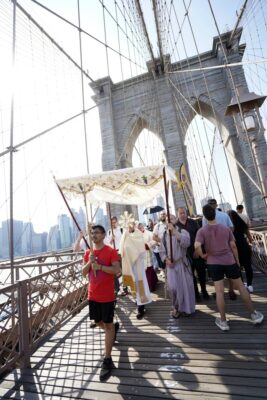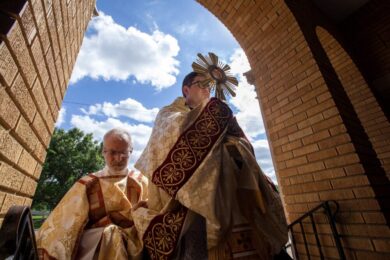July 7, 2024
Pilgrims trekking National Eucharistic Pilgrimage eyeing final destination Indianapolis with two weeks remaining
NATIONAL
By Maria Wiering, OSV News

Bishop Robert J. Brennan of Brooklyn, N.Y., carries the monstrance while leading a Eucharistic procession across the Brooklyn Bridge from Manhattan to Brooklyn on the National Eucharistic Pilgrimage’s Seton (East) Route May 26, 2024. (OSV News photo/Gregory A. Shemitz, The Tablet)
PAUL, Minn. (OSV News) — Pilgrims on the National Eucharistic Pilgrimage’s four routes are edging closer to Indianapolis, with the group traveling the northern Marian Route having arrived in Indiana July 1. Pilgrims on the other three routes will enter the state the week of July 7 before converging in its capital ahead of the National Eucharistic Congress, July 17-21.
“It’s really neat that they’re honing in” on their final destination, said Will Peterson, president of Modern Catholic Pilgrim, the Minnesota-based nonprofit that led the organization of the National Eucharistic Pilgrimage. “It’s hard to believe.”
Across their four routes, the pilgrims spent Independence Day in Michigan City and St. John, Indiana; Cincinnati; Jefferson City, Missouri; and at the Abbey of Gethsemani in Trappist, Kentucky, which was home to the influential monk, mystic and writer Father Thomas Merton from 1941 until his death in 1968.
Over the previous week, pilgrims on the four routes covered 10 dioceses. The northern Marian Route pilgrims zigzagged through the Archdiocese of Chicago, opening their time there at Mundelein Seminary with a procession, adoration and Mass for youth, and ending with Mass at the downtown Holy Name Cathedral with Cardinal Blase J. Cupich. Two recent stops highlighted the diversity within the Catholic Church, with a June 30 liturgy celebrated by Bishop Mar Joy Alappatt at the Syro-Malabar-rite cathedral in Bellwood, before crossing into the Diocese of Gary, Indiana, where pilgrims attended adoration at St. Mary’s Byzantine Catholic Church in Whiting July 1. On July 5, the Marian Route pilgrims were to enter the Diocese of Fort Wayne-South Bend, Indiana, with the pilgrims spending two days at the University of Notre Dame.
Pilgrims on the southern St. Juan Diego Route traveled through the Diocese of Nashville, Tennessee, June 25-30 and the Diocese of Owensboro, Kentucky, June 30-July 3. They entered the Archdiocese of Louisville, Kentucky, July 4 with their overnight visit to the Abbey of Gethsemani.
On the western St. Junipero Serra route, pilgrims spent June 25-29 in the Archdiocese of Kansas City in Kansas; June 29-July 1 in the Diocese of Kansas City-St. Joseph, Missouri, and July 1-5 in the Diocese of Jefferson City, Missouri. They planned to enter the Archdiocese of St. Louis July 5, where they will spend two days before continuing into the Diocese of Belleville, Illinois, July 7.
On the eastern St. Elizabeth Ann Seton Route, pilgrims spent June 24-30 in the Diocese of Columbus, Ohio, and July 1-8 in the Archdiocese of Cincinnati.
In mid-June, the 30 perpetual pilgrims — young adults traveling the full routes — marked the halfway point of the eight-week pilgrimage, which began Pentecost weekend May 18-19 in Brownsville, Texas; New Haven, Connecticut; San Francisco; and at the Mississippi River headwaters in Northern Minnesota.
On the southern St. Juan Diego Route, the milestone itself passed without major fanfare, pilgrims said, but a three-day retreat at the Shrine of the Most Blessed Sacrament in Hanceville, Alabama, proved a welcome respite. Pilgrims on all four routes took a multi-day retreat around the pilgrimage’s midpoint.
“The halfway point was fascinating, because it felt like we’ve been going for a day and also 10 years at the same time,” Charlie McCullough, a perpetual pilgrim on the Juan Diego Route, said on June 26 media call. “Every day on pilgrimage, there’s that tension between things moving very fast, but also constantly being in the present moment. And that just makes everything seem so long.

Father Matthew Nagal, pastor of Mater Dei Parish in Topeka, Kan., carries the monstrance through the archway at Church of the Assumption in Topeka where it was placed for Benediction June 27, 2024. The church was a stop on the National Eucharistic Pilgrimage’s Serra Route. (OSV News photo/Jay Soldner, the Leaven)
“Speaking for the (southern route) team, I think there was a general attitude of we were very happy with the first half of the pilgrimage,” he continued. “We were very satisfied or joyful, but we also desire more. We want to keep walking with the Lord and want to keep meeting people, and although there’s almost a wall of exhaustion we were hitting, we want to keep pouring out and keep visiting with the Lord’s people and keep bringing him to them.”
The routes will converge in Indianapolis July 16 for Mass at St. John the Evangelist, a historic downtown parish adjacent to Lucas Oil Stadium and the Indiana Convention Center, the National Eucharistic Congress’s venues. The parish plans to host Eucharistic adoration throughout the congress, serving as what event organizers have called a “spiritual hub.” The next day, the perpetual pilgrims will process into Lucas Oil Stadium as part of the congress’s opening event.
With less than two weeks remaining for the pilgrimage, Peterson said that he has been amazed since the first week at the number of Catholics who have joined the numerous Eucharistic processions.
“I don’t think I was prepared for how the public would respond to the public processions, and what it would mean,” he said.
“Even in just the first week in Minnesota, hearing about 200 people showing up for a procession in a town of 150 people — that immediate response,” he continued. “I wasn’t prepared for a priest to outfit a truck like a Eucharistic-procession-mobile in Oregon. And then in Idaho, to find out that a parishioner, without even really checking with anyone, turned his 18-wheeler into a flatbed for the bishop and the first communicants to ride on. Just the way people themselves would take ownership has been so incredible and humbling, because it’s made it possible.”
Peterson described being particularly touched by the Seton Route pilgrims’ June 28 visit to the Pickaway Correctional Institution in Orient, Ohio, for Mass and a procession. The visit also included confessions and Eucharistic adoration.
“Jesus really is everywhere,” he said. “This is the body of Christ.”
While pilgrims on other routes have prayed outside of prisons during their journeys, the Seton pilgrims were able to go inside the prison for Mass with approximately 35 incarcerated men. About 25 men were able to participate in a procession after Mass, according to The Catholic Times, the media outlet of the Diocese of Columbus, Ohio.
They were accompanied by Bishop Earl K. Fernandes of Columbus, who told the men in his homily that “there is nothing in the world that can keep Jesus’ mercy and Jesus’ love from you. Not even the walls of this place,” according to The Catholic Times.
In a video interview posted July 1 by The Good Newsroom, the digital news platform of the Archdiocese of New York, Seton Route perpetual pilgrim Zoe Dongas said that the pilgrims have a sense that “the end is in sight.”
Relating the pilgrimage to the Camino de Santiago, the popular pilgrimage to the tomb of St. James in Compostela, Spain, Dongas said, “A lot of people talk about when they’re on Camino, once they can kind of see the church at the end of the walk that they start sobbing and they get really excited, and they know it’s finally over. I think a lot of people on our team are already starting to feel that.”
Arriving at the National Eucharistic Congress is “going to be a very beautiful moment,” she said, “because we made it, and we made it with Jesus, and he is being raised up and being led into this congress.”


 Facebook
Facebook Youtube
Youtube
